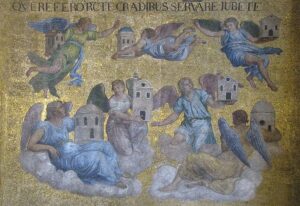“So you could not keep watch with me for one hour?
Matthew 26:40
A Holy Thursday tradition: Pilgrimage to seven churches
Holy Thursday is the feast that marks the end of Lent and the beginning of the Holy Triduum, which also includes Good Friday, Easter Vigil and Easter Sunday. At this Mass of the Lord’s Supper Catholics remember the Passover meal, when Jesus instituted the sacrament of the holy Eucharist by sharing bread and wine with his disciples, saying, “Do this in memory of Me.”
At the end of the Holy Thursday Mass, the Eucharist is placed on a temporary “altar of repose” away from the sanctuary. It is customary for the faithful to process together to this altar and spend time in quiet prayer and adoration. In the Roman Missal, it states: “The faithful are invited to continue adoration before the Blessed Sacrament for a suitable length of time during the night, according to circumstance.”
The Seven Churches Visitation is a tradition that grew out of this time of prayer and adoration. Catholics remember when Jesus asked his disciples to stay and watch with Him while they were in the garden. This tradition of mindful watching is a sort of pilgrimage to various altars of repose, in different churches that correspond to each of the seven places, or “stations,” that were made by Jesus between the Last Supper in the Upper Room to His crucifixion on the cross.
The Origin
This devotion/origin of the Seven Churches Visitation is typically credited as beginning in Rome with St. Philip Neri in the 1500’s and is practiced by Catholics around the world, including in Poland, Mexico, Italy and the Philippines. The devotion can also be traced back to the Station Churches of Rome, where the tradition is still practiced. Neri would lead groups of faithful to visit each of the seven basilicas of Rome on Holy Thursday night as a way of keeping watch with Christ as though at the Garden of Gethsemane before his passion.
 Some will argue that the Holy Thursday pilgrimage has roots in the Book of Revelation, in which the Seven Ancient Churches are visited by an angel.
Some will argue that the Holy Thursday pilgrimage has roots in the Book of Revelation, in which the Seven Ancient Churches are visited by an angel.
The Seven Churches Visitation is a powerful way to spend time in adoration, meditating on Christ’s sacrifice of love for the salvation of souls in preparation for the joy of Easter. There is something special about visiting churches late into the night. It is not just because of the opportunity to visit other parishes; it’s because of intentionally seeking Christ to spend time with Him and contemplating the gift of His love.
If you are not able to journey to seven churches you can still take part in the tradition by praying all seven stations.
What is the Seven Churches Visitation?
During Holy Week, Catholics are invited to map out seven local churches to visit after the Mass of the Lord’s Supper on Holy Thursday. These seven visits represent the final seven places or “stations” Jesus journeyed, from his arrest in the Garden of Gethsemane on Holy Thursday to his crucifixion and death on Good Friday.
In each church, pilgrims kneel before a temporary “altar of repose” — or the altar where the Eucharist, consecrated on Holy Thursday, is placed until the Mass of the Presanctified, a Christian liturgy that takes place on Good Friday (where there is no consecration.) Kneeling before the altar, Catholics make the sign of the cross, meditate on the appropriate Scripture, offer prayers, and spend time with Jesus in adoration.
This evening pilgrimage from altar to altar is a way for Catholics to spiritually accompany Christ as he enters his Passion. As Jesus asks of his apostles, in the Garden of Gethsemane, “Could you not spend one hour with me?”
Which seven places does each church represent?
The first church recalls Jesus going from the Cenacle, where he celebrated the Last Supper with his disciples, to his agony in the Garden of Gethsemane, where he prayed and sweated blood.
In the second church, Catholics meditate on Jesus being taken from the garden by the armed crowd to the house of Annas, the father-in-law of Caiaphas, the high priest, where he was interrogated and slapped in the face.
In the third church, the faithful focus on Jesus being brought to the house of Caiaphas, where he was beaten, spat upon, and insulted before enduring a painful night in captivity.
The focus for the fourth church is the first time Jesus appears before Pontius Pilate, the Roman governor of the region.
In the fifth church, the pilgrim follows the Lord as he is taken to King Herod of Judea, who mocked Jesus along with his guards.
The sixth church marks Jesus being taken from Herod and brought before Pilate for the second time and then scourged, crowned with thorns, mocked, and condemned to death.
The last church commemorates Christ carrying the cross from the Praetorium, where Pilate yielded to the crowd’s demand for his crucifixion, to Mount Calvary where he suffered excruciating pain, died, and was laid to rest in a nearby tomb until his resurrection celebrated on Easter Sunday.
What Bible passages should Catholics read at each church?
1. Jesus in the Garden of Gethsemane (Luke 22:39-46)
2. Jesus before Annas (John 18:19-22)
3. Jesus before Caiaphas (Matthew 26:63-65)
4. Jesus before Pilate (John 18:35-37)
5. Jesus before Herod (Luke 23:8-9; 11)
6. Jesus before Pilate again (Matthew 27:22-26)
7. Jesus’s crucifixion and death (Matthew 27:27-31)